
Africa is rich in traditions and culture. When it comes to weddings especially, Africans tend to go all out to ensure the day is memorable. From dancing camels in Niger to dance-offs in South Africa and henna ceremonies in Kenya and Tanzania, African wedding traditions come in various shapes and forms. The examples below reflect the rich diversity of the continent. Whether you are curious about other nations’ heritage, or just want to incorporate some African customs in your nuptials, read on! We’ve rounded up several African wedding ceremonies and practices that you might find interesting.

African Wedding Traditions: The Knocking Ceremony
It is a common practice around the world to ask for a girl’s hand in marriage. Many African wedding ceremonies cannot move forward without this step. For some ethnic groups in Ghana, the name of this ritual is “knocking on the door” or ‘kokoo ko’. The groom, together with his family on a special prearranged night and “knocks” on the door of the bride’s house. Once they are let in, they present gifts such as wine for libation, money, and kola nuts to the bride’s family. They then announce their intentions, and discuss the prospects of joining the two families through marriage. If everything goes well, the bride comes in to give her final consent as to whether or not she wants to marry the man. Marriage preparations begin as soon as she gives her approval.
Various African communities have different ways of performing the knocking ceremony. In Nigeria, the Yoruba calls it “Mo mi i mo e” (know me and let me know you). The Agikuyu community in Kenya calls it “Kumenya Mucii”(getting to know the home).

The Engagement Ceremony
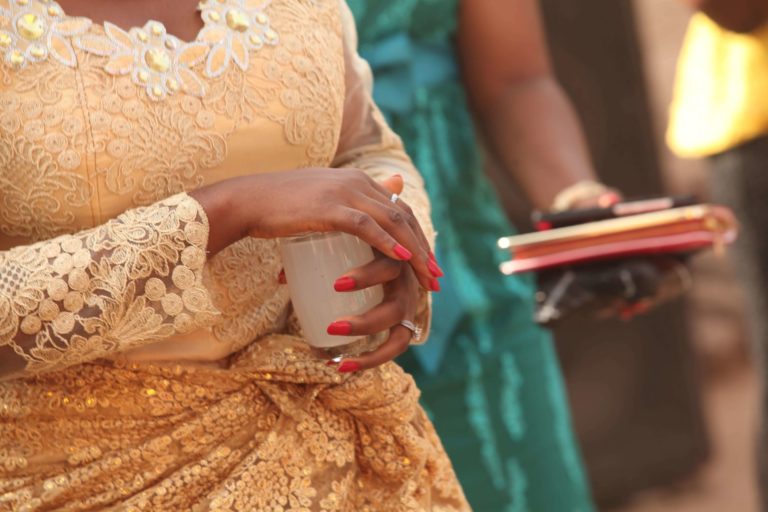
Marriage in African traditions is a union between two families, not just two individuals. That’s why an engagement ceremony, which is often also a dowry (bride price) payment ceremony, is very important. Those ceremonies bring together the whole family, and allow each side to get to know each other.
Bride price is still widely practiced remains a crucial part of many African wedding traditions. In the past, bride price was a guarantee of sexual fidelity and premarital female virginity. It was also a way for the groom to demonstrate that he was a good provider, who would take good care of the bride.
The ceremony differs slightly from country to country. In Burkina Faso, the Moaga tribe calls it “Poug PousSôm” or PPS for short. On this day, the groom’s family goes to the bride’s family to offer the “negotiated” bride price. This can be in the form of money or animals, cereals, kitchen utensils or clothes. Everyday consumer goods like kola nuts and dolo (millet beer), or services (fieldwork, repairing huts, etc) are also commonplace.
During the ceremony, the sisters and girlfriends of the bride jokingly hide some items from the groom’s family such as shoes. They then require money to return the items. This is done to show the groom and his family that they cannot “snatch” their friend or sister so easily from the family. After the PPS, cohabitation is socially accepted, though there’ll usually still be a religious or civil wedding.
Each community in Africa has its own way of celebrating the engagement ceremony. In Kenya, the Agikuyu community calls it “Ruracio”, while in South Africa the Zulus call it “Lobola”.
Bride price remains a crucial aspect of many African wedding traditions.

Kola nut offerings
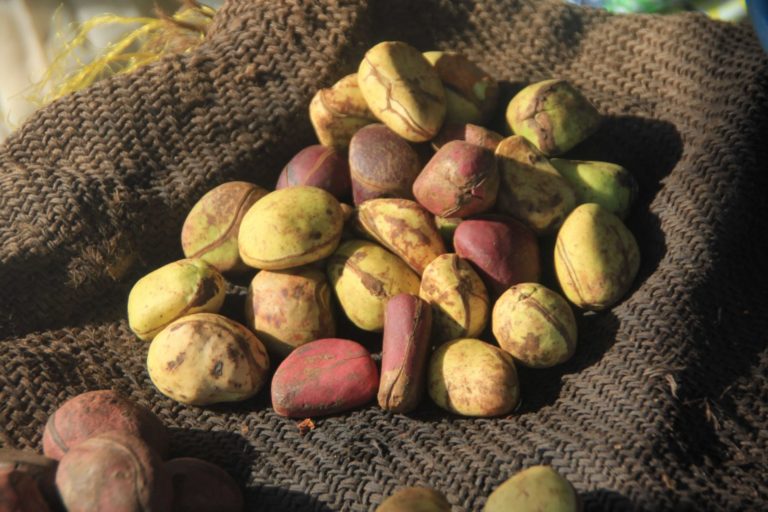
Kola nuts play an important part in many West African wedding traditions. The caffeine-packed nut grows on a big tree, in tropical forests in West Africa. It is often used for medicinal purposes. Kola nut is also a symbol of healing, respect, hospitality, and unity.
In the Gambia, if a man sees a woman he wants to marry, he first sends a kola nut as greetings and declaration of his proposal. If it is accepted, representatives of the man’s family meet with the girl’s family. They decide on the dowry, which is then followed by a date for the “breaking of the kola nut” (marriage). The traditional wedding ceremony ends with the breaking of the kola nut. It is then shared among relatives and elders.
Other African communities that include kola nuts in their wedding traditions are Nigeria, Ghana, Sierra Leone, and Liberia.

The henna ceremony
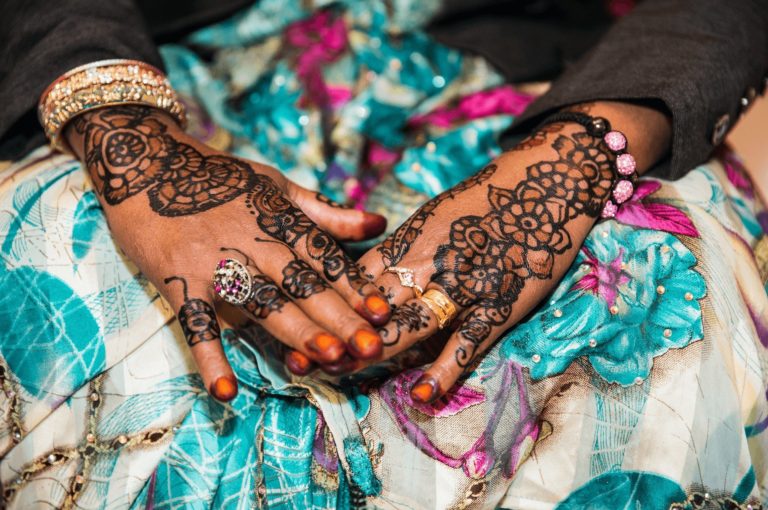
An American or European bride would go for a spa treatment before the big day. An African bride has a pampering day as well, with a little twist. In various communities around East, West, and Northern Africa, the brides and her female companions have a “henna ceremony/party” several days before the wedding ceremony.
Among the Swahilis in Kenya and Tanzania, this celebration may take from two days to a week. It often involves a lot of rituals such as bathing and putting perfume on the bride, hairdressing, and body decorations with henna. Female family members and friends can also partake in this ritual by applying henna on various parts of their bodies such as arms, legs, and feet. This ceremony is usually accompanied by songs and prayers for the newlyweds. Advice is given to the bride by older family members, and this part of the ceremony is very emotional.
In Niger, the Hausa and Tuaregs communities also apply henna to symbolize purity and fertility.

African Wedding Traditions of Submission
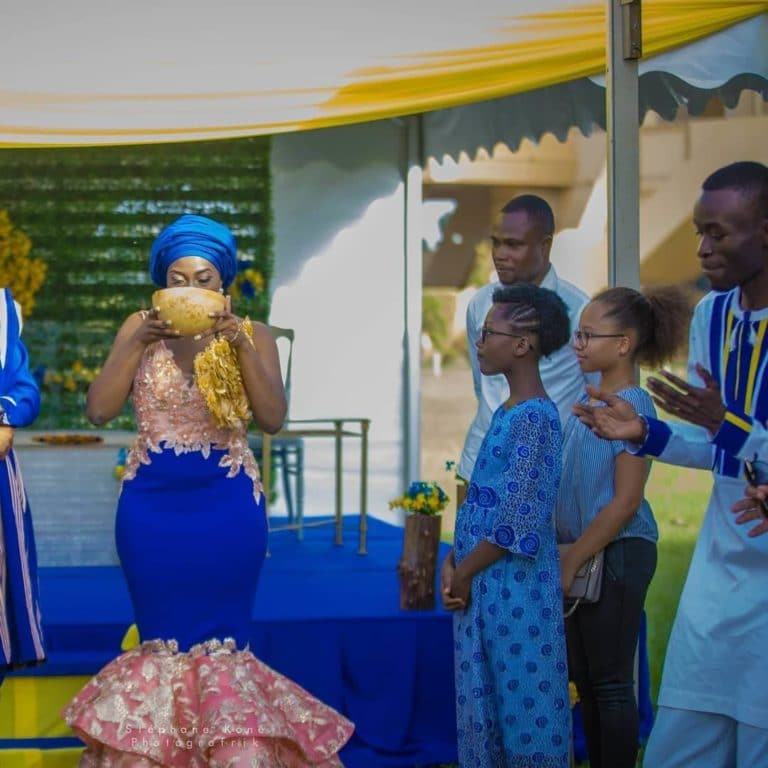
Just like in the Christian faith, several African cultures teaches about submission to one’s husband. That’s why it is common in many African countries to see a bride kneeling before her husband during an African wedding or engagement ceremony.
In Burkina Faso, during the traditional engagement ceremony, brides from the Mossi (or Moagha) ethnic group are given a drink by their younger cousins. The bride is supposed to taste the drink first, before offering it to her husband on her knees. Blogger @reunissouslebaobab gives us a perfect demo in the image above, at her own wedding.
In Yoruba traditions, you’ll also find the bride kneeling to place a cap on her husband’s head. The husband normally reciprocates the attention, by spraying her with money and lifting her in the air.

Matching Outfits (Aso Ebi)
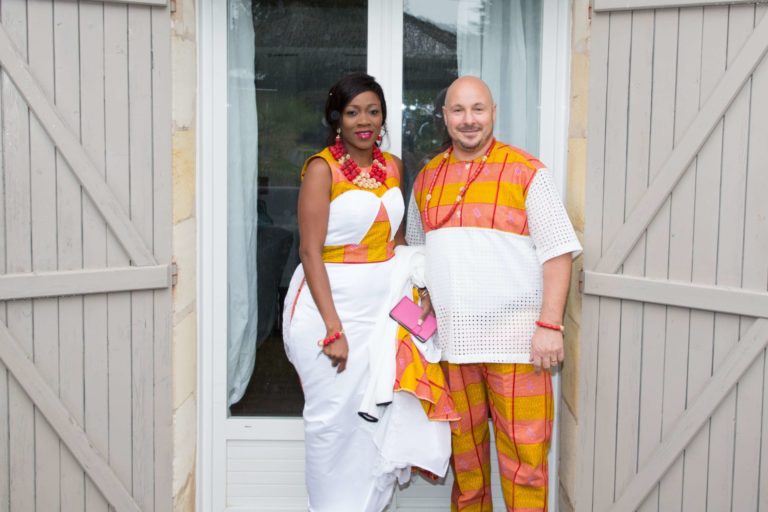
Having matching outfits for the bridesmaids is a pretty common wedding tradition around the world. African engagement ceremonies and African wedding ceremonies take it a notch higher, by also matching close friends, sisters and cousins.
This practice is especially popular in West Africa regions and involves a ceremonial uniform cloth known as “Aso Ebi” in Yoruba. The word “Aso” means cloth and “Ebi” means family, so it literally means “family cloth”. It a way for friends to show closeness to the family during ceremonial events. It can be made out of polyester, cotton, or other fabrics.
Although the fabric is the same, women usually design their own style. The bride’s mother and groom’s mother can also choose to pick out their own cloth for their close family, relatives, and associates to wear.
This practice is also called Sanga Willi in the Dioula language, spoken in Burkina Faso, Mali and Côte d’Ivoire.

All hail the Queen (and king)
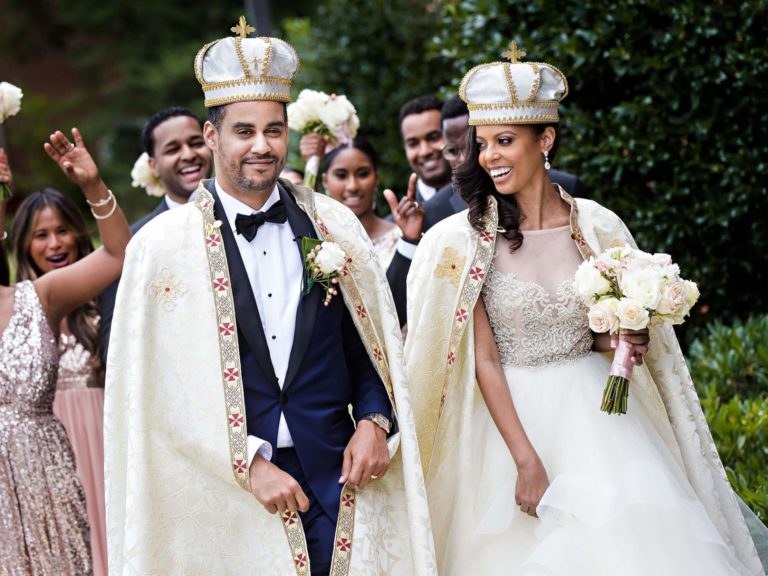
While every bride would like to feel like a queen on her wedding day, some Ethiopian brides actually looks and dresses like one. Indeed, parts of Ethiopia are predominantly Christian. To be more precise, a percentage of the Ethiopian population belongs to the Ethiopian Orthodox Tewahedo Church.
The main part of an Ethiopian Orthodox Tewahedo Church wedding ceremony is the Crowning of the couple. The ceremonial crowns are made out of semi precious stones and metals, and threads of gold and crimson. They are placed on top of these African bride and groom’s heads, as a symbol of their new status as King and Queen of their new households. The priest blesses the crowns in the name of Trinity. They then swap them three times between the couple to seal the union. The bride and groom also don royal garments including embroidered capes, robes, and jewelry. The image above is a snapshot of Prince Yoel of Ethiopia and philanthropist Ariana Austin on their wedding day.

Tasting of The Four Elements

You’ve likely heard the saying that marriage is not a bed of roses? It comes with its trials and tribulations, that only the resilient can survive. The Yoruba ethnic group (present in countries like Nigeria, Niger and Benin) have a wedding tradition called the tasting of the four elements. During that ceremony, the bride and groom get a literal taste of flavors that represent the distinct stages in a marriage.
A lemon slice is for sour to represent the disappointments the couple will face. A sip of vinegar is for the bitterness they must overcome in fights and trying times. Cayenne is a hot element to show a way of bringing spice and passion to the relationship. Finally, a sweet spoonful of honey to show the joy in marriage.
By tasting each of these flavors, the couple symbolically demonstrates that they will be able to overcome everything together. Photo above used with the permission of Trystan Photography.

Proposal Letters
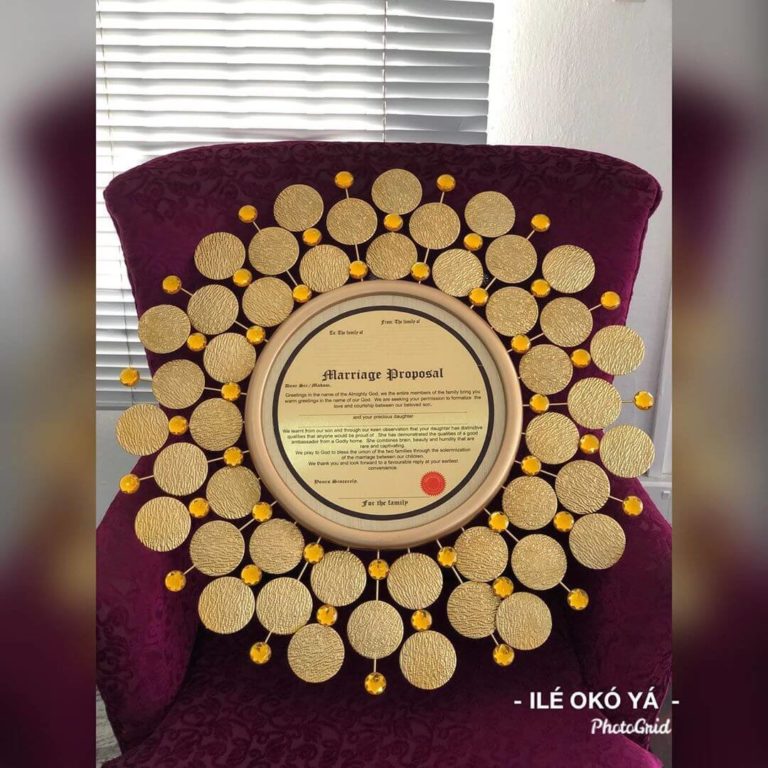
Like most African wedding ceremonies, a South African wedding is vibrant with color, culture, music, and dancing. But before a Zulu wedding takes place, the groom and his family must first write a letter to the family of the future bride to formally ask for them to meet. The letter must clearly state their intention. It must also detail the exact date when the lobola (bride price) negotiation will take place. The bride’s family then replies to the letter by either confirming the set date or changing it to a date that they are more comfortable with. Side note: customs in Nigeria also include proposal letters. Those can be very elaborate! In the photo, please see an example of a traditional proposal letter, made by the traditional wedding planners at Ilé Okó Yá.
After the lobola, the South African bride and groom will have a wedding ceremony which normally takes three days and starts on a Friday. On that day, the groom’s family goes to the bride’s family house. They watch each other dance and sing traditional songs. The “white” wedding happens the following day in the church. On Sunday, the bride is taken to her new home where the traditional wedding (Umabo) takes place.

Dance-Offs
The Zulu traditional wedding (Umabo) takes place at the family home of the groom. The bride will leave her home early in the morning, covered in a blanket. She is advised not to look back, so as not to invite bad luck. Her father takes her to her new family home and on arrival, she walks around the house to be introduced to her husband’s ancestors. She later enters the house through the kitchen before anyone notices her. The groom’s family then pays a penalty for not being aware of the bride.
Before the traditional wedding ceremony, the man’s family must first slaughter a cow to welcome the bride. On that day, the bride wears traditional clothes such as soft leather aprons and a beaded necklace and headdress. The groom wears a lion’s skin. The two families exchange gifts and have a dance-off. The latter symbolizes the bride leaving her ancestral home to join her husband’s.

African Wedding traditions of Libation
Respecting elders and honoring ancestors is a large part of many African cultures. Therefore, a libation ceremony often takes place in major African events, including weddings. In many African traditional weddings (in Ghana, Burkina Faso and more countries), an elder is responsible to perform them. They pour holy water or alcohol on the ground. in each of the four cardinal directions. They then recite prayers to the ancestral spirits, and calls out the names of those that have recently passed away. This tradition is aimed to appease the ancestors and bless the bride and groom.

Money Spraying
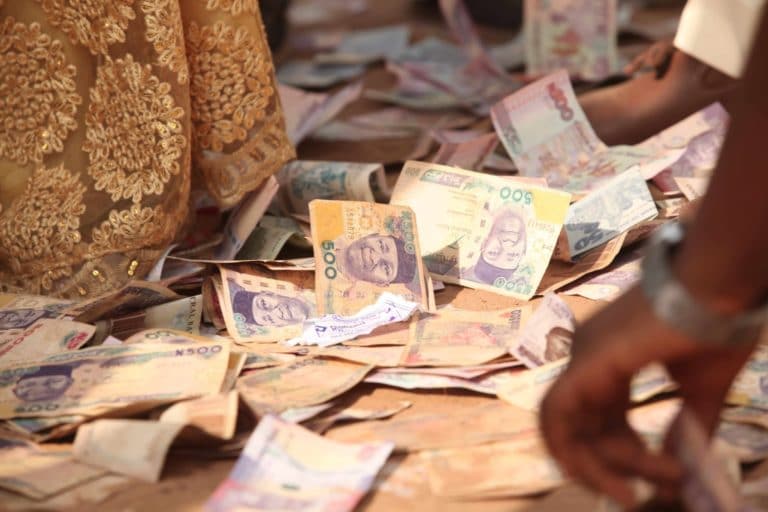
A popular African wedding tradition especially in West Africa is to spray money on the bride while she dances during the wedding ceremony. Of course, only crisp notes are encouraged. Older guests are usually the ones throwing the money (but anyone can participate) to show their happiness for the couple. It is also a basic show of flamboyance and affluence, and a symbol of a prosperous future for the bride and groom. The bridesmaids usually collect all of the thrown money. They later give it to the newlyweds.
There’s no specific time allocated for family and friends to spray money on the bride and groom, but the best time is when the couple hit the dance floor.
Note: this is also a practice prevalent outside of Africa. In Armenia, money is sprayed on the couple during their first dance, in a ritual called “Shabash“. Likewise, it is meant to bring good luck and financial success in their lives.

No Smiling
For most couples, their wedding day is the happiest day of their life if their beaming faces are anything to go by. But that’s not the case for some Congolese brides and grooms. Marriage is considered a serious affair. Indeed, for some ethnic groups in Congo and not something to laugh or smile about. Traditionally, during their entire wedding ceremony including the reception and the photo session, the bride and groom were not allowed to smile. If they did, it would mean that they are not serious about marriage. Things have changed, and Congolese weddings these days are full of happiness and smiles, from everyone involved.

Dancing Camels
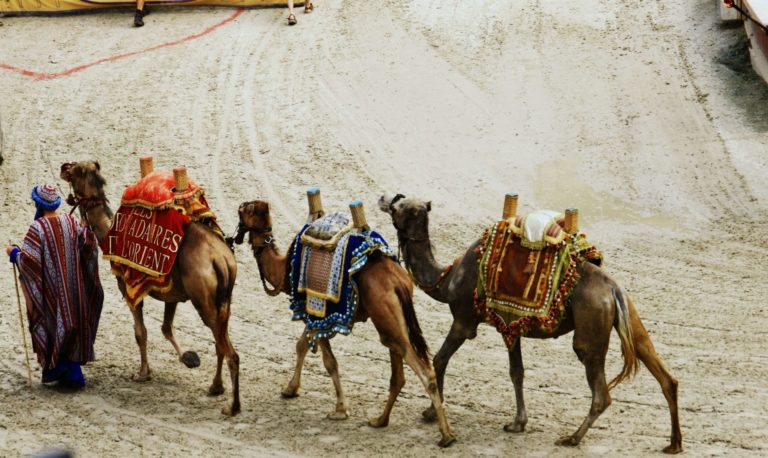
Dancing at a wedding is a tradition shared across the world. In fact, no wedding ceremony is complete without people getting their groove on at the reception. But, in the West African country of Niger, the camel does the dancing.
Among the Tuaregs in Niger, tradition dictates that if a young man is interested in a girl, he sneaks up to her house that she shares with her parents and tickles her ear. If the girl is not interested, she will cover her head and he must leave immediately. But if she is interested, she will talk to him and give him a pendant as a token of her acceptance. The parents will then meet to discuss bride price and the wedding ceremony will take place on a full moon and after the wedding, a trained camel will show off its dancing moves to the guests along to a drum beat. That drum is a traditional Touareg instrument, called the Tendé (in the Tamasheq language.)

Cooking for the in-laws
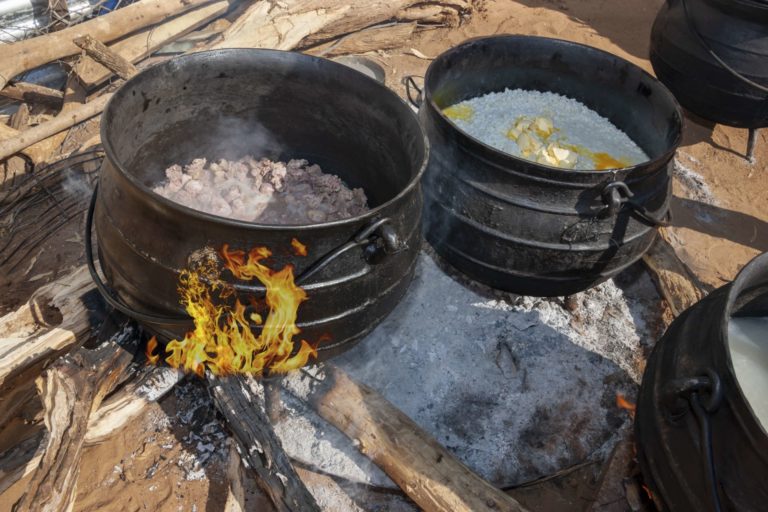
In Burkina Faso, on the 7th day after the wedding, the Mossi (or Moagha) bride is supposed to cook the country’s traditional dish for her in laws. Said dish is a tasty maize paste called tô. It is generally accompanied with a sauce (okra sauce is a favorite) and a soup. In the meantime, at the bride’s father’s house, a sheep is killed. Its meat is used to make soup. The bride’s family then sends some emissaries over to the in-laws’. That delegation brings over the last of the new bride’s housewares, along with the soup, which is shared with the in-laws. After the meal, the bride’s family heads home. However, they also pack up all the bones from the meat they just ate. Per tradition, they bury those bones along the way. None of the bones must make it back to the bride’s dad’s house, to avoid bad luck for the newlyweds.

African American Wedding Traditions: Jumping The Broom
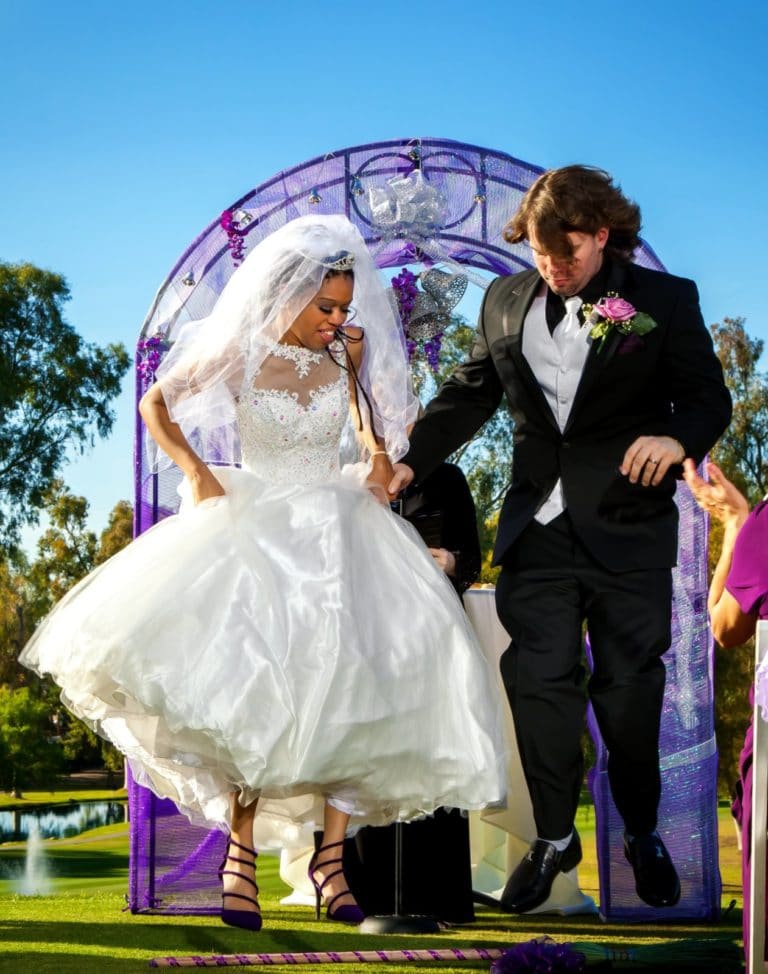
Jumping the broom is one of the most widespread wedding traditions among the black community in the United States. Just like the phrase suggests, the bride and groom literally jump over a broom together. This act signifies their entrance into a new life and their creation of a new family. They are symbolically “sweeping away” their former single lives and concerns.
It’s not clear where this tradition originated from. Some trace it back to the Welsh-Romani gypsy communities in the 18th century. Others believing that it might have originated from Ghana.
Either way, slaves in the Southern United States used this practice in the 1840s and 1850s. Indeed, at that time, they could not legally wed. This resulted in many couples holding secret ceremonies where they would jump the broom to signify their commitment to each other. The phrase “jumping the broom” therefore became synonymous with “getting married.”
Side note- if this is a practice you are planning on adding to your wedding, make sure the shape of your dress will make it easy to jump the broom!
There you have it, some of the most interesting African wedding traditions practiced in various parts of the continent. Of course, 54 countries cannot have their culture summarized in one post. We still did our best to cover some great African wedding traditions in this post! Seen one that got your attention? Know of any that we left out? Please let us know in the comment section. Make sure to take advantage of our planning tips, in case you are to add one of the above to your celebration.
Otherwise, thanks a lot for reading our blog post, and feel free to contact us on any questions you might have! If planning your wedding includes getting a wedding dress, we would love to help you create the dress of your dreams. Book a consultation with our team, or drop us a line through our contact form or via email.
See you soon for more brides and wedding tips!
Best,
JoSaBi


